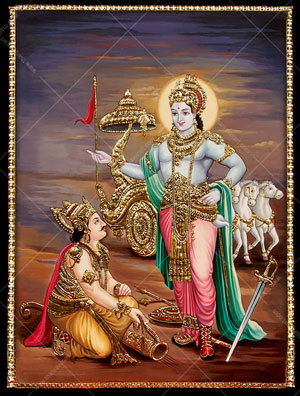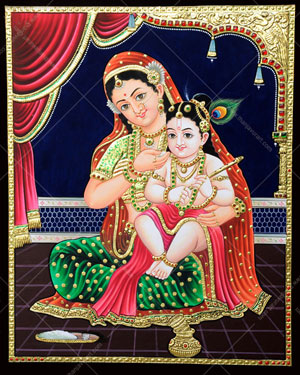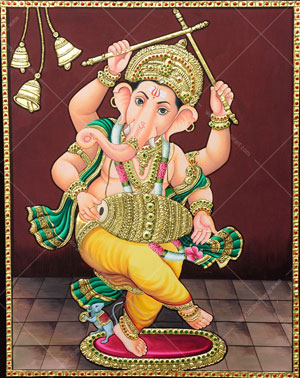What is Thanjavur Painting?
Thanjavur paintings basically signify those created using a unique style and technique, which originated in Thanjavur during the Maratha period in the 16th Century.
A typical Thanjavur painting would have a main figure, a deity, with a well-rounded body and almond shaped eyes. This figure would be housed in an enclosure created by means of an arch, curtains, etc. The painting would be made by the gilded and gem-set technique - a technique where gold leaves & sparkling stones are used to highlight certain aspects of the painting like ornaments, dresses, etc.
As you would see, the paintings would be bright, vibrant and breathtakingly beautiful. The impact in a darkened room is that of a glowing presence. While most of the paintings would depict the Child Krishna and his various pranks, paintings of other deities were also created.
Over a period of time, changes have occurred in the stylization - for example, the figures are no longer round. Presiding deities of various famous temples are also being depicted in the paintings. The technique is now more in use than the style.
Traditional Thanjavur paintings are possessed as heirlooms.


How Thanjavur Paintings are made?
Thanjavur paintings are done on canvasses. The canvas for a Thanjavur painting is usually a plank of wood (originally wood of the Jackfruit tree was used, now it is plywood) over which a layer of cloth is pasted with arabic gum.
The cloth is then evenly coated with a paste of limestone and a binding medium and let to dry. The canvas is now ready for painting. The artist then draws a detailed sketch of the painting on the canvas. A paste made of limestone and a binding medium are used to create a 3D effect in embellishing and ornamenting the theme using a brush. Gold leaves and gems of varied hues are used in selected areas like pillars, arches, thrones, dresses, etc. The shine and glean of the gold leaves used by the Thanjavur style paintings last forever. Finally, colours are applied on the sketch. In the past, artists used natural colours like vegetable dyes, whereas the present day artists use chemical paints which enhance the sharpness and provide better shade contrasts. The old Tanjore artists restricted their scope to divine figures and used to mix their natural colours. The modern ones have, of course, no need to do so. What has survived in this convention is the choice of colours for painted personalities or objects.
About the Artist
Mr. C.Kamaraj - Artist
He has over 23 years of experience in creating unique and colourful Thanjavur paintings. His paintings are on display in leading Thanjavur paintings galleries and commercial places. He is also the owner of Sudharsan Thanjavur paintings (in Trichy) and www.thanjavurart.com
Contact Details
Phone No. +91 94437 65771
